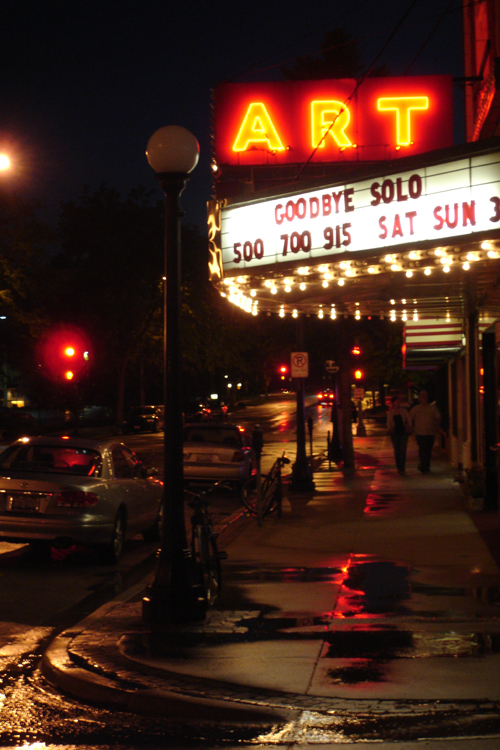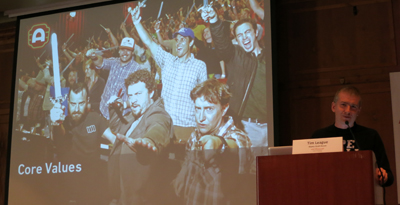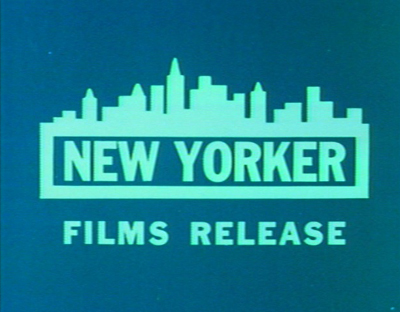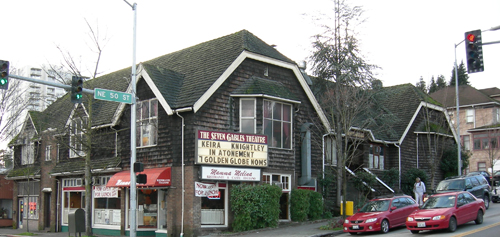Pandora’s digital box: Art house, smart house
Monday | January 30, 2012 open printable version
open printable version
The Art Theater, Champaign, Illinois. Photo by Sanford Hess, reproduced with permission.
DB here:
Theatres’ conversion from 35mm film to digital presentation was designed by and for an industry that deals in mass output, saturation releases, and quick turnover. A movie comes out on Friday, fills as many as 4,000 screens around the country, makes most of its money within a month or less, and then shows up on VoD, PPV, DVD, or some other acronym. The ancillary outlets yield much more revenue to the studios, but the theatrical release is crucial in establishing awareness of the film.
Given this shock-and-awe business plan, movies on film stock look wasteful. You make, ship, and store several thousand 35mm prints that will be worthless in a few months. (I’ve seen trash bags stuffed with Harry Potter reels destined for destruction.) Pushing a movie in and out of multiplexes on digital files makes more sense.
After a decade of preparation, digital projection became the dominant mode last year. Today “digital prints” come in on hard drives called Digital Cinema Packages (DCPs) and are loaded (“ingested”) into servers that feed the projector. The DCPs are heavily encrypted and need to be opened with passkeys transmitted by email or phone. The format is 2K projection, more or less to specifications laid down by the Digital Cinema Initiatives (DCI) group, a consortium of the major distributors.
Upgrading to a DCI-compliant system can cost $50,000-$100,000 per screen. How to pay for it? If the exhibitor doesn’t buy the equipment outright, it can be purchased through a subsidy called the Virtual Print Fee. The exhibitor can select gear to be supplied by a third party, who collects payment from the major companies and applies it to the cost of the equipment. The fee is paid each time the exhibitor books a title from one of the majors. See my blogs here and here for more background.
It’s comparatively easy for chains like Regal and AMC, which control 12,000 screens (nearly one-third of the US and Canadian total), to make the digital switchover efficiently. Solid capitalization and investment support, economies of scale, and cooperation with manufacturers allow the big chains to afford the upgrade. But what about other kinds of exhibition? I’ve already looked at the bumpy rise of digital on the festival scene. There are also art houses and repertory cinemas, and here one hears some very strong concerns about the changeover. “Art houses are not going to be able to do this,” predicts one participant. “We will lose a lot of little theatres across the country.”
The long, long tail
‘Plexes, whether multi- or mega-, tend to look alike. But art and rep houses have personality, even flair.
One might be a 1930s picture palace saved from the wrecking ball and renovated as a site of local history and a center for the performing arts. Another might be a sagging two-screener from the 1970s spiffed up and offering buns and designer coffees. Another might look like a decaying porn venue or a Cape Cod amateur playhouse (even though it’s in Seattle). The screen might be in a museum auditorium or a campus lecture hall. When an art house is built from scratch, it’s likely to have a gallery atmosphere. Our Madison, Wisconsin Sundance six-screener hangs good art on the walls and provides café food to kids in black bent over their Macs.
Most of these theatres are in urban centers, some are in the suburbs, and a surprising number are rural. Most boast only one or two screens. Most are independent, but a few belong to chains like Landmark and Sundance. Some are privately held and aiming for profit, but many, perhaps most, are not-for-profit, usually owned by a civic group or municipality.
What unites them is what they show. They play films in foreign languages and British English. They show independent US dramas and comedies, documentaries, revivals, and restorations.
In the whole market, art houses are a blip. Figures are hard to come by, but Jack Foley, head of domestic distribution for Focus Features, estimates that there are about 250 core art-house screens. In addition, other venues present art house product on an occasional basis or as part of cultural center programming.
Art house and repertory titles contribute very little to the $9 billion in ticket sales of the domestic theatrical market. Of the 100 top-grossing US theatrical releases in 2011, only six were art-house fare: The King’s Speech, Black Swan, Midnight in Paris, Hanna, The Descendants, and Drive. Taken together, they yielded about $309 million, which is $40 million less than Transformers: Dark of the Moon took in all by itself. And these figures represent grosses; only about half of ticket revenues are passed to the distributor.
More strictly art-house items like Take Shelter, Potiche, Bill Cunningham New York, Senna, Snow Flower and the Secret Fan, Certified Copy, Page One, The Women on the 6th Floor, and Meek’s Cutoff took in only one to two million dollars each. Other “specialty titles” grossed much less. Miranda July’s The Future attracted about half a million dollars, Uncle Boonmee Who Can Recall His Past Lives grossed $184,000, and Godard’s Film Socialisme took in less than $35,000. For the distributors, art films retrieve their costs in ancillaries, like DVD and home video, but the theatres don’t have that cushion.
Something else sets the art and rep houses apart from the ‘plexes: The audience. It’s well-educated, comparatively affluent, and above all older. Juliet Goodfriend’s survey of art house operators indicates that only about 13% of patrons are children and high-school and college students. The rest are adults. A third of the total are over sixty-five. As she puts it, “Thank God for the seniors!” However much they like popcorn, they love chocolate-covered almonds.
Almonds aside, how will these venues cope with digital? To find out, I went to Utah.
Harmonic Convergence
Tim League, Alamo Draft House, during his keynote address at the Art House Convergence.
Five years ago, the Sundance Institute founded the Art House Project, a group of theatres that could screen a tour of Sundance Festival films. The original members recognized the advantages of collaborating, and Russ Collins of the Michigan Theatre organized an annual meeting held just before the festival. In its first year, 2008, the Art House Convergence attracted twenty-two people. This year it drew nearly three hundred—not only programmers and operators and major speakers, but delegates from distribution companies, service firms, and equipment manufacturers. To my eye, it’s becoming an informal trade association.
My three and a half days at the Convergence in Midway, Utah filled me with information and energy. Having attended one of the classic art theatres in my youth, the Little Theatre in Rochester, New York, I’ve been a patron in this sector for fifty years. But I never really met the people behind the scenes. This bunch is exuberant and committed to sharing their love of cinema. They want to watch a movie surprise and delight their audiences. Ideally, the customers would so completely trust the programmer’s judgment that they would come to that theatre without knowing what’s playing.
If you wonder where old-fashioned movie showmanship went, look here. These folks mount trivia contests, membership drives, singalongs. They help out with local film festivals. They bring in filmmakers and local experts for Q & A sessions. They screen those plays, operas, ballets, and concerts that attract a broader arts audience. The bigger entities, like the Bryn Mawr Film Institute and the Jacob Burns Film Center, offer courses in filmmaking and appreciation, along with special events for children, teenagers, and other sectors of the community.
Everything is about localism. These people know their customers, often by name. They sense the currents of taste crisscrossing their town. The success of the Alamo Draft House reveals that Austin has a demographic hungry for the kung-fu classic Dreadnaught, an Anchorman quote-along, or a compilation of the worst CGI work in film history. In LA, The Cinefamily attracts a crowd ready to watch Film Socialisme alongside Battle Royale, Pat O’Neill films, and the 1927 Casanova. “Mission” was a word heard often heard in Midway. These people aren’t only about making money but about weaving unusual cinema into the fabric of their town’s culture and subcultures.
The classic art house was mission-driven too, and it could pay a little as well. Before the advent of videotape, you could make decent money showing Ealing comedies, Fellini, and Bergman years after their initial release. Some exhibitors continue as profit-driven businesses. But many, perhaps most, people in the Project operate not-for-profit venues. The cinemas are funded by donations, foundations, and government agencies, such as arts councils. Russ Collins has argued for embracing this trend.
“New model” Art House cinemas are community-based and mission-driven. . . . Most “new model” Art House cinemas are non-profit organizations managed by professionals who are expert in community-based cinema programming, volunteer management and the solicitation of philanthropic support from local cinephiles and community mavens.
Russ points out that over the twentieth century, opera, theatre, and other sectors of the performing arts have moved toward non-profit status. “If it makes sense that if music has a range from very commercial to very subsidized, film should too. There are all kinds of movies, and there should be all kinds of outlets.” The University of Wisconsin–Madison Cinematheque and the Wisconsin Film Festival have shown me that this strategy can work—again, if the programming meshes with the tastes of its community.
There are clouds on the horizon, of course. Gary Palmucci of Kino Lorber recalled a line from Irvin Shapiro, who distributed foreign-language films for fifty years: “When were there ever not problems?”
For example, the baby-boomers, cinephiles since the ‘60s, are likely to be around for ten or fifteen more years. Where will new patrons come from? When I was in college, you scheduled your life around theatres’ showtimes, but younger people have gotten used to time shifting and on-demand access via tape, disc, cable, or the Web. A more worrisome sign: even in art houses near college campuses, students tend to make up a small fraction of the audience. The next few years will tell if changed tastes, along the habit of unbridled access to movies, will keep an aging Gen X from the art house.
More pressing the problem is digital conversion. It was the topic of two information-filled sessions at the Convergence, and it came up often during other panels.
Where do they get those movies?
An AHC panel: Russ Collins, Ira Deutchman (Emerging Pictures), Jeff Lipsky (Adopt Films), and Gary Palmucci (Kino Lorber).
Historically, most major new film technology was introduced in the production sector and resisted in the exhibition sector. Exhibitors have been right to be conservative. Any tinkering with their business, especially if it involves massive conversion of equipment and auditoriums, can be costly. If the technology doesn’t catch on, as 3D didn’t in the 1950s, millions of dollars can be wasted.
Shooting movies on digital was no threat to theatres as long as 35mm prints were the standard for screening. But distribution has long been the most powerful and profitable sector of the film industry. Today’s major film companies—Warners, Paramount, Sony et al.—dominate the market through distribution. So when the Majors established the Digital Cinema Initiatives (DCI) standards, exhibitors had to adjust.
Since distributors call the tune, let’s look at the different digital alternatives available.
Mainstream commercial films from the major studios are currently distributed in both 35mm copies and digital copies. But at some point fairly soon, the majors will cease releasing 35mm. Twentieth Century Fox has taken the lead in declaring that at the end of this year it will circulate no more film prints. John Fithian, the plain-spoken President of the National Association of Theatre Owners, said in March of 2011:
Based on our assessment of the roll-out schedule and our conversations with our distribution partners, I believe that film prints could be unavailable as early as the end of 2013. Simply put, if you don’t make the decision to get on the digital train soon, you will be making the decision to get out of the business.
This means that the theatre will require full 2K/4K projection, and the exhibitor will need a DCI-compliant projector and a server for every screen. To pay for the upgrade, many exhibitors will want to take advantage of the Virtual Print Fee. But many VPF programs have set their signup deadlines during this year.
Arthouse films distributed by studio subsidiaries are the tentpoles and blockbusters of the arthouse market. Sony Pictures Classics, Universal Focus, and Fox Searchlight usually furnish the most desirable pictures for these screens. Add in certain titles supplied by “mini-majors” like Relativity, The Weinstein Company, and Lionsgate/ Summit. This season, for instance, art houses would have suffered without Tinker Tailor Soldier Spy (Focus), The Descendants (Fox Searchlight), A Dangerous Method and The Skin I Live In (SPC), and The Iron Lady, The Artist, and My Week with Marilyn (Weinstein).
As far as I can determine, all these firms currently supply 35mm prints. Jack Foley of Focus recognizes that film copies remain the default for most art houses. For Focus, 35mm circulation makes sense because many films play widely enough and roll out slowly enough to amortize print costs.
Focus will be patient with its core customers and their financial challenges in going digital. . . . Supplying them with 35mm in the meantime allows us to play them and play them cheaply by using prints multiple times at no cost more than shipping.
But studio subsidiaries must also provide the DCI-compliant Digital Cinema Packages. Some art houses have converted and can handle them. More important, many of these films play in “smart houses.” These are screens, located in a mainstream multiplex, that will show films that get good response in art-house runs. If a movie has crossover appeal, a smart house can hold it long enough to build word of mouth. Right now, several multiplexes are playing Tinker Tailor, The Descendants, My Week with Marilyn, and the like. There are, Jack Foley estimates, between 250 and 500 screens of this sort in the country.
Smart houses, as parts of multiplex circuits, are usually showing DCPs. At the moment, Foley points out, the Virtual Print Fee is onerous for non-major distributors, since if they supply a DCP to a theatre, they must pay the fee (often about $850). Foley believes that eventually all viable art houses will convert to DCI projection, the VPFs will expire, and every party will reap the benefits of digital cinema.
Films distributed by smaller, independent distributors offer still other options. These are companies like Kino Lorber, IFC, Magnolia, Strand, Roadside Attractions, Oscilloscope, Zeitgeist, and their peers. They circulate the most offbeat product, dramas like The Messenger and Meek’s Cutoff (Oscilloscope), along with documentaries and foreign titles like Cave of Forgotten Dreams, Pina, and Certified Copy (IFC) and 13 Assassins (Magnolia). Restorations and reissues of classics, such as Metropolis (Kino Lorber) and On the Bowery (Milestone), operate in this sector as well. Like their studio counterparts, these firms need the video aftermarket to support purchasing theatrical rights.
Some of these distributors supply 35mm prints, like Magnolia’s very pretty one of Melancholia that I saw in Madison a few weeks ago. But most Virtual Print Fee agreements apparently demand that if a non-Majors film arrives on DCP and is to be played on a projector financed through the VPF, the independent distributor must chip in the fee. Some are willing to do that.
What surprised me most was learning that independent distributors will supply the film in many digital formats, even Blu-ray and DVD versions. There are now first-run films playing commercial theatres, even in Manhattan, in Blu-ray. On small screens, many exhibitors say, that format works fine and their patrons don’t notice. Many of these films aren’t available on 35mm prints at all, although a distributor may prepare a print if there’s enough interest to help pay for it.
A lateral option, sometimes called i- or e-cinema, also exists. There are now companies offering theatre delivery via the Internet. The idea is to stream encrypted files, in HD, to cinemas signed onto the system. Emerging Pictures, currently the dominant player in this domain, will deliver material from many independent distributors, including Sony Classics, IFC, and Magnolia. Emerging will also supply performing arts shows. Other companies offering or preparing to offer comparable services are Specticast, Proludio and Storming Images.
Summing up: If an art house wants to show only films from the independent, second-tier distributors, then the pressure to convert to DCI isn’t great. The exhibitor will, however, be playing more and more movies on DVD or Blu-ray. But the fact is that one Iron Lady pays for a lot of Take Shelters. The need to show art house blockbusters will eventually push most art-house operators toward buying or leasing the high-end equipment.
In between
Juliet Goodfriend, Art House Convergence. Photo by Chuck Foxen, reproduced with permission.
The new digital problems confronting the art-house market don’t end with decisions about equipment.
For one thing, DCP playback creates a degree of inflexibility that festivals have also encountered. Shifting showtimes and screens is more difficult, as it may require special permission and a new key to open the file. There is, moreover, an air of surveillance that is inimical to the more informal, trust-based atmosphere of most art-cinema milieus.
More constraints appear if the exhibitor chooses to fund the changeover through the Virtual Print Fee. For example, VPFs oblige the exhibitor to screen only films supplied by the major companies–the ones that created the Digital Cinema Initiatives. If an exhibitor wants to play an independent distributor’s title on a DCP, that distributor needs to pay the fee, in effect helping to cover the theatre’s conversion. Other constraints are more obscure. I can’t report reliably on them because when joining a VPF program, the exhibitor signs a non-disclosure agreement pledging not to reveal details of the deal. But hints suggest that exhibitors could be prevented from “splitting,” that is showing two or more films in the same auditorium on one day. This is a practice that many art cinemas rely on because it allows them to vary programs in mid-week, or to compensate for having only one or two screens.
Another effect of the digital revolution comes from streaming, or Video on Demand. Many of the most desirable films from independent distributors are released on VoD simultaneous with or even before theatrical release. At the Convergence, one exhibitor pointed out that Melancholia was available on VoD several weeks before she could play it on her screen.
Distributors offer several justifications for their streaming decisions. Ancillary income from DVD has declined steeply, and VoD pays well. According to Josh Dickey’s Variety article and Daniel Miller’s Hollywood Reporter piece on the rise of VoD deals, Margin Call, which attracted $5.3 million theatrically, took in an estimated $4-$5 million on VoD. Another advantage is that streaming provides fast returns, while any DVD income won’t show up for many months. Moreover, VoD can reach audiences in areas of the country that don’t have art houses. And some distributors believe that the theatrical and VoD audiences don’t significantly overlap. For Margin Call, it’s claimed, most people who saw it in the theatre didn’t know that it was on VoD, and many who caught it on VoD would not have gone to a theatre.
There don’t seem to be any firm conclusions about how much day-and-date or early release on VoD can harm a film’s theatrical release. In the absence of detailed evidence about VoD grosses, exhibitors are understandably nervous.
Finally, what about access to older films in studio collections? These titles are central to repertory cinemas, and many art houses that play recent releases schedule some classics too. Yet some studios are increasingly reluctant to supply 35mm prints from their libraries. If the film isn’t on DCP, exhibitors may be told that they must pay to have a DCP made, or show a Blu-ray or DVD. But repertory cinemas are reluctant to screen on the low-resolution formats, and rarer and more obscure titles are unlikely to be available on disc. Unhappily, we may get less repertory programming on the whole. Audiences that don’t live in a town with an archive or cinematheque will have less chance to discover film history.
A tradition, forced to reconfigure
The energetic arts entrepreneurs who gathered at Midway can claim a proud tradition. The art-house and repertory model of exhibition, originating in the 1920s, came to prominence after World War II. These theatres played imported films from small distributors, with occasional independent items mixed in. A 1949 Variety article noted that the market had a boom that was starting to level off.
Postwar surge of art theatres, born as an outlet for the flock of British and foreign-lingo pix which hit this country after V-J Day, is now slowing to a normal growth. In the U. S. at the present time there are 57 theatres which are out-and-out art houses and 226 additional flickeries which play foreign-made product part of their time. . . . With the exception of Newark. . . every city of 200,000 or over now sports at least one art theatre.
Then as now, these theatres offered a more personal atmosphere and upscale service (tea, coffee). Like today’s art houses, they depended on what we call buzz; their films were very much critic-driven. Then as now, British films could break out, with Henry V (1944), Hamlet (1948), and The Red Shoes (1948) proving very successful. The major studios sensed a new market and began financing and importing films from overseas. This policy has been revived several times since, up to today’s “studio boutiques” like Focus and Sony Classics. And some art-house operators moved into distribution themselves. Exhibitor-distributors like Cinema 5 and New Yorker are the predecessors of IFC and Music Box.
This system of distribution and exhibition has survived six decades. But in that period, art houses haven’t faced any change as sweeping as this. The big distributors have decided on a standard, and the most powerful theatre chains have converted. History suggests that critical mass on this scale is irresistible.
Many major art houses and nonprofits have already converted. Film Forum in New York City, which mixes repertory and new releases, has long had a policy of showing classics on 16mm or 35mm film. But now the theatre is using DCPs; some restorations are not offered on film, and that trend is almost certain to grow. Taking the bull by the horns, Film Forum is running a series, “This is DCP,” to introduce the audience to the format. Bruce Goldstein’s program note asks:
Is watching a DCP the same experience as watching a film print? The jury is still out, so for this one-week series, we’ve chosen the crème de la crème of classics on DCP and have invited Sony Pictures’ Grover Crisp, one of the true giants of film restoration, to explain things on opening weekend. You be the judge.
Exhibitors who haven’t yet converted are raising funds through information campaigns and capital exercises. Single-screeners face the toughest climb. Take the Art Theatre of Champaign, Illinois, seen in my topmost still. It opened in 1913 and has had a pretty typical history (including showing erotic films). Revived as an art house in 1987, it has screened foreign and independent cinema, as well as classics and out-of-the-way items, including a revival of City of Lost Children. Now the Art needs to go digital. Its operator, Sanford Hess, stresses that without the new gear, priced at about $80,000, he will have to close the venue when the lease runs out in December. He has started to rebuild the enterprise as a co-operative. Since the co-op launched in December, 270 people have bought shares, generating about $29,000 toward a new projection system. (You can trace the progress of the campaign on Facebook.)
David Hancock of IHS Screen Digest suggests that 5% of US screens could disappear during the conversion. That number sounds small, but it amounts to nearly 2000 screens, and many are likely to be in art houses. The prospects remind me of 1928, when the studios agreed to shift to talking pictures. Put aside your pity for those actors like George Valentin in The Artist. Harder hit were the people who worked at the more than four thousand movie theatres too small, too remote, or too poor to be wired for sound. Of course that technological shift took place during the Great Depression. But our economy isn’t looking exactly vigorous, and in some ways today’s technological changeover is more hazardous. 1930s audiences didn’t have cable and Netflix to make staying home more attractive.
This is the fifth in a series on the transition to digital projection.
Thanks to Jack Foley of Focus Features distribution for sharing information with me. I also got useful information from Michael Barker of Sony Pictures Classics, Mike Maggiore and Bruce Goldstein of Film Forum, Jim Healy of our Cinematheque, Sanford Hess of the Art Theatre, and Merijoy Endrizzi-Ray of Sundance 608.
I’m very grateful to Jan Klingelhofer of Pacific Film Resources, Russ Collins of the Michigan Theater Foundation, and the membership of the Art House Project for welcoming me so generously to their annual Convergence. Special thanks as well to Juliet Goodfriend, Cordelia Stone, and Valerie Temple of the Bryn Mawr Film Institute for their survey of the art-house market, which I have drawn on here. That online survey, conducted in late 2011, collected data from 126 theatres in 29 states and Canada. I also benefited from conversations with Lisa Dombrowski, who’s writing a book on specialty cinema in the US, and Jenn Jennings, who is making a film, The Lost Picture Show, about digital conversion.
A good overview of the early development of digital art-house exhibition is offered by Michael Goldman’s 2008 article, “Digitally Independent Cinema,” in Filmmaker magazine. The Variety article I quoted from is “7 out of 10 Sureseaters Click” (27 July 1949), 13. For the history of art cinemas, see Michael F. Mayer, Foreign Films on American Screens (Arco, 1965); Barbara Wilinsky, Sure Seaters: The Emergence of Art House Cinema (University of Minnesota Press, 2001); and Kerry Segrave, Foreign Films in America: A History (McFarland, 2004). Tino Balio’s The Foreign Film Renaissance on American Screens, 1946-1973 (University of Wisconsin Press, 2010) traces the phenomenon from the standpoint of distribution. I discuss Tino’s book more here.
Box office figures for recent releases are taken from Box Office Mojo. My figures on theatres that closed during the conversion to sound come from The Film Daily Yearbook from the years 1931-1935. The process, which has many analogies with today’s digital conversion, is discussed in Donald Crafton, The Talkies: American Cinema’s Transition to Sound 1926-1931, vol. 4 in History of the American Cinema, ed. Charles Harpole (Scribners, 1997), Chapter 11, and Douglas Gomery, The Coming of Sound (Routledge, 2005), Chapter 8.
Seven Gables Cinema, Seattle, Washington. Photo by Joe Mabel. Reproduced under Gnu Free Documentation License.
PS 20 February: John Fithian, President of the National Association of Theatre Owners, confirms the prospect of theatre closures here: “For lower-grossing theaters, it’s just not affordable. I predict we’ll lose several thousand screens in the U.S.”




















